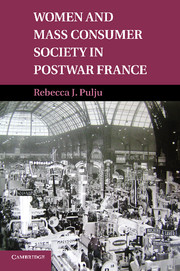Book contents
- Frontmatter
- Contents
- List of Figures and Tables
- Acknowledgments
- Abbreviations
- Introduction
- 1 Consumers for the Nation
- 2 The Productivity Drive in the Home and Gaining Comfort on Credit
- 3 For Better and For Worse
- 4 “Can a Man with a Refrigerator Make a Revolution?”
- 5 The Salon des arts ménagers
- Epilogue
- Bibliography
- Index
- References
2 - The Productivity Drive in the Home and Gaining Comfort on Credit
Published online by Cambridge University Press: 01 March 2011
- Frontmatter
- Contents
- List of Figures and Tables
- Acknowledgments
- Abbreviations
- Introduction
- 1 Consumers for the Nation
- 2 The Productivity Drive in the Home and Gaining Comfort on Credit
- 3 For Better and For Worse
- 4 “Can a Man with a Refrigerator Make a Revolution?”
- 5 The Salon des arts ménagers
- Epilogue
- Bibliography
- Index
- References
Summary
In October 1957, the journal of the Union national des caisses d'allocations familiales (UNCAF), the network of organizations that distributed family welfare funds in France, published an article on the economic value of housework. In order to demonstrate how a housewife's competence and knowledge could influence both family life and national revenue, the author described the technique ménagère of Mme L, a housewife with four young children. Mme L, “was aware that her work enriched her home and benefitted society in the same way that it would were she to exercise a professional occupation.” She created a relaxing environment with regular meal and sleeping times that kept her loved ones healthy, sparing both her family and the nation the cost of medical care, and ensuring that those old enough to work were not weakening production by depriving the nation of their labor. Mme L's purchases “affected the sector of production” and she disciplined producers by choosing the most essential and highest quality foods, and oriented production toward cheap, modern goods through her furniture purchases.
Mme L was certainly productive, but the author went on to explain how much more productive housework could be with access to a washing machine, a vacuum, an electric floor polisher, and a rationally constructed kitchen. These would allow women to do more work in less time and to achieve better results. With the time that machines saved, “women could dedicate more time to another productive task.”
- Type
- Chapter
- Information
- Women and Mass Consumer Society in Postwar France , pp. 59 - 94Publisher: Cambridge University PressPrint publication year: 2011

